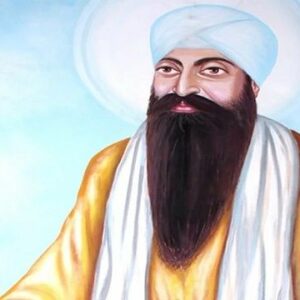Guru Arjan Dev was the fifth Sikh Guru out of ten. He was the first Sikh martyr when he was arrested on the orders of Mughal Emperor Jahangir and tortured to death for refusing to convert to Islam. His martyrdom marked a critical turning point in Sikhism’s history. The previously peaceful community took up arms in self-defense and to preserve the rights of the weaker parts against the Mughals’ atrocities. Guru Arjan Dev was the son of Sikhism’s fourth Guru, Guru Ram Das. Following his father’s demise as a Sikh leader, he went on to have a vital influence on the growth of Sikhism. His reign as a guru lasted 25 years, during which time he made numerous significant contributions to the Sikh religion. He finished the construction of Amritsar, which went on to become one of the most prominent Sikhism centers. He collated the hymns of past Sikh Gurus, as well as chosen works of other saints from various backgrounds who he believed, were consistent with Sikhism’s teachings. He was a peaceful and saintly man who was revered by people of all faiths, which made the Mughals feel uneasy and jealous. As a result, Jahangir had him apprehended and executed.
Childhood and Adolescence
Arjan Dev was born in Goindval, Tarn Taran, India, on April 15, 1563, to Guru Ram Das, Sikhism’s fourth Guru, and his wife Mata Bhani. Prithi Chand (Prithia) and Mahadev were his older brothers.
Guru Ram Das had noted from an early age that his youngest son Arjan was wise above his years and had compassion for all. He also demonstrated himself to be a very religious and humble young man in his dedication to humanity.
Parthia, Arjan Dev’s older brother, wished to be the next guru after their father. He was dissatisfied with Arjan’s growing reputation in their father’s eyes, as he feared Arjan would inherit the Guru Gaddi. Parthia plotted to ruin the reputation of his younger brother but failed miserably. Guru Ram Das eventually chose Arjan Dev as his successor.
A Later Years
After Guru Ram Das’ death in 1581, Guru Arjan Dev became the Sikhs’ fifth Guru. When he assumed the Guru Gaddi, he carried on his father’s legacy and established Amritsar as a key Sikh pilgrimage destination by continuing the efforts of the late Guru Ram Das. He also designed Amritsar’s Harmandir Sahib.
Guru Arjan Dev enhanced the Masands system established by his predecessor and emphasized the Dasvand principle, according to which a tenth of an individual’s income was paid to the Guru’s Langar (Common Kitchen) and other charitable deeds for the poor’s benefit.
He intended to give Sikhism its own sacred scripture, so he collated all of the previous Gurus’ writings as well as the works of saints from other backgrounds whose teachings were consistent with Sikhism’s ideals. Sri Guru Granth Sahib, the Sikhs’ sacred book, was founded on this collection of teachings and hymns. He also composed the Sukhmani Sahib Bani and provided more than 2,000 hymns.
Guru Arjan Dev became a well-known spiritual figure, with throngs of people of various faiths flocking to meet him and seek his blessings. Sikhism grew steadily during his reign, with increasing numbers of Hindus and Muslims joining the guru’s ranks. Sikhism quickly rose to prominence as the most prevalent religion in medieval Punjab.
The Mughals were immensely disturbed by the guru’s and Sikhism’s growing popularity. They were envious of the guru’s fame and enraged that numerous Muslims had converted to Sikhism. Emperor Jahangir, who had recently ascended the throne, was an Orthodox Muslim who saw the spread of Sikhism as a threat to his dominion.
Guru Arjan Dev was to be arrested and taken to Jahangir. He then threatened to torture and execute the guru unless he converted to Islam. The guru stayed true to his faith till the end.
Guru Arjan’s Martyrdom
In 1606 the Guru was imprisoned in Lahore Fort. He was subjected to terrible torture because he refused to convert. He was forced to sit on a searing hot plate after being plunged into boiling water, which scalded his skin. More torture followed, including the application of hot sand to his body.
The atrocities continued for days, but the guru remained true to his beliefs and endured them all while speaking the name of God. The cruelty meted out to this pious and calm individual astounded the bystanders.
The guru was permitted to bathe in the Ravi River after being tortured for many days. Guru Arjan Dev entered the river on May 30, 1606, and was never seen again.
His Major Projects
The Harmandir Sahib was designed by the guru, who had the intention of having a central site of devotion for Sikhs (also known as the Golden Temple today). The acceptance of persons of any faith, color, creed, or sex was symbolized by the doors on all four sides of the structure. One of India’s most popular tourist destinations in the Golden Temple.
Guru Arjan Dev compiled the hymns of the first five Sikh gurus and 15 other renowned saints, or bhagats, including thirteen Hindu and two Muslim saints, to create the first rendition of the Sikh holy text, the Adi Granth. He wrote 2218 hymns for the sacred text himself. The first text, with Baba Buddha as the first granthi, was completed and installed at the Harmandir Sahib in 1604.
Personal History and Legacy
Mata Ganga was Guru Arjan Dev’s wife. Hargobind was the couple’s only child.
Guru Arjan Dev named his son Hargobind as the future guru while awaiting execution, instructing him to take up arms and combat Islamic persecution under Mughal control.
Estimated Net worth
Guru Arjan Dev’s estimated net worth is $ USD 5 million, with his primary source of income being religious leader, and writer.


